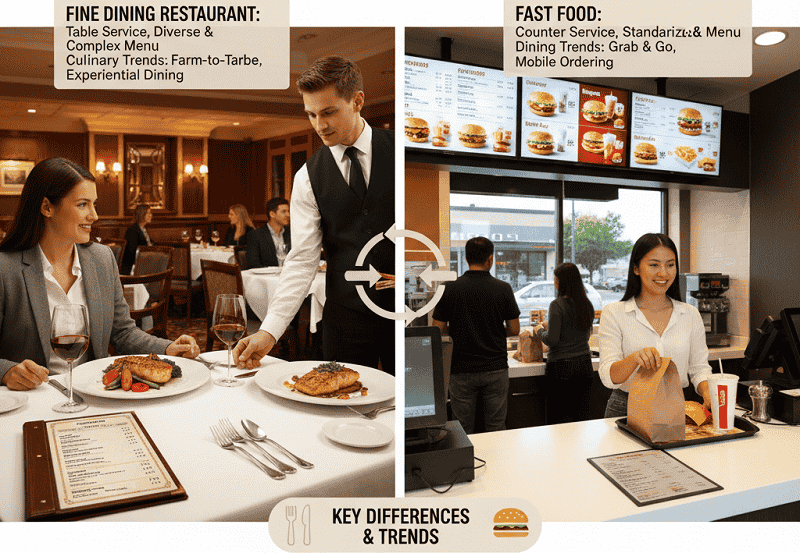Blog
Home /Blog-DetailsRestaurant or Fast Food: Key Differences, Menus & Dining Trends

Introduction
When people search for “restaurant or fast food,” they’re often trying to understand the difference between the two, or looking for the best option for their next meal. While both serve food, the experience, pricing, and even menu choices can be very different.
A restaurant is a broad category covering everything from fine dining to casual food spots. On the other hand, fast food has carved out its own space in modern dining, built on speed, affordability, and convenience.
In this guide, we’ll break down what makes a restaurant different from fast food, explore the rise of fast casual restaurants, compare their menus, and highlight current dining trends in 2025. Whether you’re a diner, a restaurant owner, or just curious, this article will help you make sense of today’s ever-changing food landscape.
What Is a Restaurant?
A restaurant is any place where food and drinks are prepared and served to customers, usually for immediate consumption. Unlike fast food outlets, restaurants can vary widely in style, service, and menu design. Some offer full table service, while others lean toward self-service or counter ordering.
Types of Restaurants
- Fine Dining: Formal service, gourmet menus, and higher prices.
- Casual Food / Casual Dining: Relaxed atmosphere, moderate pricing, sit-down service.
- Casual Fast Dining / Quick Casual Restaurant: A hybrid between fast casual and traditional dining—often offering quick service with an upgraded ambiance.
- Fast Food: The most standardized type, focused on speed and affordability.
Restaurants play a big role in shaping local food culture, offering everything from traditional family meals to innovative fusion menus. Because the term covers such a wide spectrum, it’s important to understand where fast food fits in as a subset of the restaurant industry.
What Makes a Restaurant Fast Food?
Not every restaurant qualifies as fast food. So, what makes a restaurant fast food? The defining characteristics are:
Core Characteristics
- Speed and Convenience: Food is prepared quickly, often pre-cooked or assembled.
- Standardized Menus: Limited variety but high consistency across locations.
- Affordable Pricing: Targeting mass audiences with value meals and combo deals.
- Minimal Service: Counter ordering, drive-thrus, or kiosks instead of full wait staff.
Pros of Fast Food
- Budget-friendly, accessible to almost everyone.
- Ideal for people with busy schedules.
- Widely available with global presence.
Limitations
- Perceived as less healthy due to fried or processed ingredients.
- Less customization compared to casual fast dining or fast casual restaurants.
- Heavy competition and small profit margins per meal.
Global examples include McDonald’s, Burger King, Subway, and KFC, all built on delivering a predictable, quick dining experience.
Fast Casual and Quick Casual Restaurants
In the U.S., fast casual restaurants have become especially popular in urban areas. Many restaurants in Washington and Seattle are adopting this model to balance speed with fresh, high-quality meals. Similarly, restaurants in New York have embraced quick casual service, catering to busy professionals who want healthier choices without sacrificing time.
Definition
These establishments combine the speed of fast food with the quality of sit-down restaurants. Customers order at the counter but enjoy fresher ingredients, healthier options, and a more inviting atmosphere.
Menus & Experience
- Fast Food Menus: Simple, fixed combos, fewer options.
- Fast Casual Menus: Build-your-own bowls, fresh toppings, seasonal specials, and health-conscious alternatives.
- Décor and seating are more upscale than fast food, often with open kitchens and modern design.
Examples
- Chipotle: Known for customizable burritos and bowls.
- Shake Shack: Famous for its gourmet-style burgers and shakes.
- Panera Bread: Offering fresh soups, salads, and bakery items.
Fast casual dining is growing because today’s diners want both speed and quality—something between fine dining and fast food.
Restaurant vs Fast Food vs Fast Casual
Whether you’re exploring restaurants in New York for late-night bites, checking out trendy restaurants in Seattle, or looking for affordable restaurants in Washington, the same distinctions apply:
|
Feature |
Fast Food |
Fast Casual |
Casual Dining |
|
Price |
Low |
Moderate |
Moderate–High |
|
Service |
Counter/Drive-Thru |
Counter + Better Ambience |
Full Service |
|
Menu |
Limited, Standardized |
Customizable, Fresh |
Extensive, Varied |
|
Speed |
Very Fast |
Moderate |
Slower (table service) |
|
Ambience |
Basic |
Modern/Trendy |
Comfortable, Relaxed |
Trends in 2025
- Fast food chains are adding healthier or premium menu items.
- Fast casual brands are testing drive-thrus for convenience.
- Consumers want value but won’t compromise too much on taste or nutrition.
Conclusion
The debate around restaurant or fast food applies everywhere—from the bustling restaurants in New York to trendy restaurants in Seattle and family-friendly restaurants in Washington. Each dining model has its own strengths, and the right choice depends on what you value most: speed, price, or experience.
In 2025, the lines between these categories continue to blur. Whether you prefer the convenience of fast food, the balance of fast casual, or the experience of full-service dining, understanding the differences can help you choose your next meal more wisely.
Want more insights on dining trends, restaurant marketing, or menu strategies? Explore our latest guides and resources to stay ahead in the food industry.